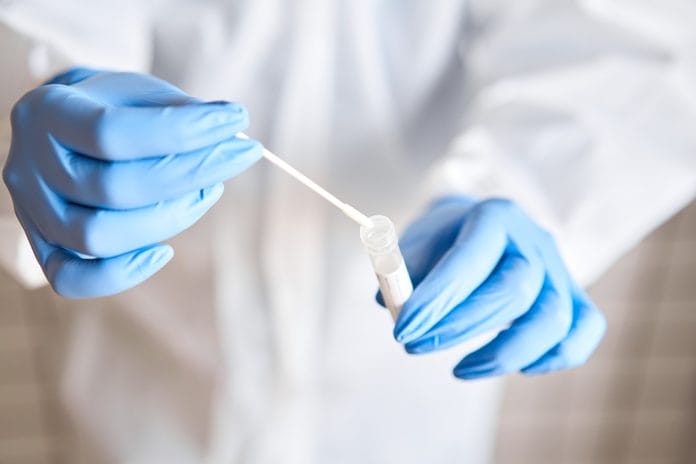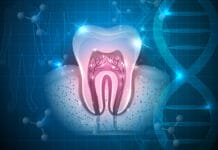In dentistry, saliva has traditionally been more of a nuisance than anything else. Dental hygienists know the constant struggle of trying to keep patients from choking during a prophy or attempting to keep a tooth dry when placing a sealant.
Yet, what if saliva holds the key to integrating medicine and dentistry? Salivary diagnostics is an insightful tool that dental professionals can incorporate to help patients better manage a range of health issues − from caries risk to diabetes.
Saliva is colorless, odorless, and has a pH of 6.6-7.1.7 Whole saliva is a mixture of secretions from the major and minor salivary glands (the parotid, submandibular, and sublingual glands account for 90% of saliva production), gingival crevicular fluid, serum and blood derivatives from oral wounds, desquamated epithelial cells, expectorated bronchial and nasal secretions, bacteria and bacterial products, viruses and fungi, other cellular components, and food debris.4,7
Saliva contains minerals, electrolytes, buffers, enzymes and enzyme inhibitors, growth factors and cytokines, and immunoglobulins.7 This secretion has several beneficial actions in the oral cavity including neutralizing organic acids produced by plaque, discouraging the growth of bacteria and inhibiting infection, and protecting the hard and soft tissues from drying. Saliva provides calcium and phosphate for remineralization, recycles ingested fluoride into the mouth, and carries topical fluoride around the mouth to promote remineralization. Saliva also initiates the digestion process, facilitates chewing and swallowing, and speeds the oral clearance of food.8
The Hope for Saliva Diagnostics
Salivary flow rate is an important factor in oral health. The unstimulated flow rate should be assessed at a patient’s initial visit and yearly; 600mL of serous and mucinous saliva is secreted from human salivary glands each day.7 The average flow rate is 0.3-0.4mL per minute but drops to virtually zero while sleeping.2
Reduced saliva flow can contribute to dental caries, mucositis, fungal infections, and periodontal disease.5. The most common causes of the decline of salivary output are medications, autoimmune disorders, menopause, malnutrition, frequent, long-lasting fasting, and labile type 1 diabetes.1
Salivary glands are composed of two regions − the acinar and ductal. Protein synthesis, fluid generation, and secretion take place in the acinar region. Secretion from salivary glands is controlled by the autonomic nervous system. Salivary glands have high permeability and are surrounded by capillaries, blood, and acini that exchange molecules.
Historically, blood is the most frequently used specimen in clinical chemistry. There are two main purposes for analysis: Identifying individuals with disease and monitoring the progress of individuals under treatment.
Researchers are hopeful that salivary diagnostics can provide the same uses. Biomarkers in blood infiltrate acini and are secreted into saliva. Saliva is becoming more accepted as a pool of biological markers that vary from changes in biochemicals, nucleic acids, and proteins to the microflora.7 Saliva contains cell-free DNA that is 70% host and 30% oral microbiota. Salivary DNA is very stable and relatively high quality making it useful for the development of biomarkers.2
Biomarkers are present in blood and saliva, but research has shown that higher levels occur in saliva. Salivary biomarkers have been investigated for diagnosis and monitoring of systemic diseases like diabetes, cardiovascular disease, autoimmune disorders including Sjogren’s syndrome, cystic fibrosis and various cancers including oral squamous cell carcinoma.5
Salivary diagnostics is economical and offers ease of access and other benefits to both patients and health-care workers. Health-care workers report a reduced risk of transmission of infectious diseases and cross-contamination, the ability to collect multiples samples, and real-time diagnostic values. Saliva does not clot and is more easily manipulated than blood.
For patients, non-invasive collection and, in some cases, the option to screen and collect at home are positive aspects.7 These benefits lead to increased acceptance as well as decreased anxiety and discomfort for patients. This is especially helpful in pediatric practices. Methods of saliva sample collection are spitting, suctioning, draining, or collection on an absorbent material.1,5
In 2004, the National Institute of Dental Craniofacial Research invested in two landmark initiatives to first decipher human salivary proteome and then to develop point-of-care microfluidic devices that can assay particular proteins for personalized precision medicine applications. Since then, salivaomics has developed as the integrative study of saliva and its constituents, functions, and related techniques.2 It involves genomics, transcriptomics, proteomics, metabonomics, and microRNA analysis.
Diagnostic Applications of Saliva
Periodontal disease − Periodontal disease is a chronic inflammatory response of the periodontium to bacterial plaque deposited on teeth. Porphyromonas gingivalis is most closely associated with periodontal disease. Salivary biomarkers used for diagnosis and prognosis of periodontal disease include inflammation-mediating enzymes, epithelial keratins, immunoglobulins, salivary ions, and hormones.
Levels of aspartate aminotransferase (AST) and alkaline phosphatase (ALP) are elevated in periodontal disease. AST can be used as a marker to monitor periodontal disease.7 Researchers have developed saliva kits based on an enzyme-linked immunosorbent assay to specifically detect AST in saliva in 90 seconds with 92% sensitivity and 96% specificity.
Caries activity − Saliva has preventive functions like flushing and neutralizing the oral cavity (called salivary clearance).1 The helpful buffers in saliva are directly proportional to flow rate, meaning that low unstimulated salivary flow rate can lead to increased xerostomia, delays clearance of food from the mouth, and increased caries risk.
Salivary pH also plays a role in caries risk. Enamel erosion begins at a pH of 5.5, and caries at 5.2.2 Dental caries prevalence directly correlates to the microbial load of Streptococcus mutans and Lactobacilli in saliva.7
Oral cancer and systemic malignancies − Early diagnosis is key to a good prognosis with any cancer. Somatic mutations of tumor-specific DNA cause the onset and development of malignancy and can be detected in saliva. Research has shown tumor-specific DNA to be positive in 100% of saliva samples of those with oral tumors.
DNA and mKNA are used in the diagnosis of oral squamous cell carcinoma, the most common form of oral cancer. Tumor-specific biomarkers can also be found in saliva for non-small cell lung carcinoma, early and advanced-stage prostate cancer, and breast cancer among others.7
Cardiovascular disease − Cardiovascular disease encompasses a group of disorders of the heart and blood vessels, including atherosclerosis, myocardial infarction, and coronary heart disease. Salivary markers of cardiovascular disease are C-reactive protein (CRP), myoglobin, creatinine kinase myocardial band, and cardiac tropins.
CRP is an inflammatory mediator that is released in response to acute injury or infection. Salivary CRP levels have been found to correlate with plasma CRP levels in blood samples obtained for a population at risk for cardiovascular complications making saliva an acceptable option for preventive testing.7
Viral infections − Diagnosis of viral infections is dependent on salivary biomarkers like viral DNA and RNA, antigens, and antibodies. HIV, hepatitis C, HHV-6 human cytomegalovirus, and HPV are some of the detectable viruses in saliva, in some cases with more sensitivity than in a blood sample.7
Saliva has a high consistency rate (greater than 90%) when compared to nasopharyngeal specimens in the detection of respiratory viruses, including coronaviruses.7. COVID-19, a novel coronavirus, is a kind of viral pneumonia that has been identified in the saliva of infected patients − sometimes up to 29 days after infection.
Saliva can have a pivotal role in human-to-human transmission. Researchers from RUCDR Infinite Biologics at Rutgers University have successfully validated saliva as a viable biosample source for COVID-19, and the FDA recently approved an at-home saliva test (not yet available to the public). Saliva testing for COVID-19 is non-invasive and cost-effective. Adding this point-of-care option may increase testing, early detection, and help to minimize global shortages of swabs.6,7
Autoimmune disorders − Elevated, specific biomarkers in saliva can be the first sign of several autoimmune disorders. Host genome in saliva can also be used with next-generation sequencing to reveal genomic variants to predict the risk of certain health conditions as well.2
Sjogren’s syndrome is a chronic autoimmune disorder characterized by reduced secretions of the salivary glands. Reduced oral phosphate levels in combination with xerostomia can lead to caries, infections, oral pain, and even difficulty swallowing. Elevated levels of cytokines and antibodies in saliva may help to diagnose a patient with Sjogren’s syndrome and help providers make appropriate plans concerning oral health.7
Cystic fibrosis is an inherited disorder due to a mutation of the transmembrane conductance regulator gene. Salivary diagnostics of a patient with cystic fibrosis may show elevated levels of calcium and phosphate, lower salivary volume, and decreased pH. These patients may present with heavy plaque and calculus due to the increase in calcium and phosphate in combination with lower salivary clearance.7
Diabetes is a metabolic disease caused by a lack of insulin secretion, insulin action, or insulin resistance. These issues impair the body’s ability to process blood glucose. Research shows that alpha-2-macroglobulin in saliva and HbA1c have a positive correlation that may demonstrate alpha-2-macroglobulin is a good reflection of glycemic control in patients with type 2 diabetes mellitus.7
Diabetes is a chronic condition that is also linked to the gut microbiome. Alterations in the gut microbiome cause a pathogenic shift in the oral microbiome that may increase bone loss and inflammation leading to periodontal disease. Conversely, dysbiosis in the oral microbiome can be a causative link to gut composition leading to inflammation in organs and tissues.3
Gut microbiota − The oral and gastrointestinal tract microbiome account for the bulk of the overall human microbial load. The spectrum of oral microbiota has been found to be a good representation of the upper GI tract.
Overall, health can be negatively affected by gut dysbiosis. Salivary diagnostics can be a so-called gatekeeper in monitoring components of gut microbiome changes that may exacerbate allergies, diabetes, inflammatory bowel disease, and neurological conditions.3
Current challenges to salivary diagnostics include identification of disease-specific markers, sensitivity and specificity of tests, standardization of collection, and storage of saliva samples. There are currently no FDA approved salivary diagnostic tests for evaluating the risk of periodontal disease, caries, or head and neck cancers.5
Dental hygienists should consider incorporating salivary diagnostics as a way to personalize dental care and raise the standard of care we provide. Make testing a part of the initial exam and use during evaluation for preventative and restorative treatment of dental caries to assess how overall treatment has affected oral health.
Testing may benefit elderly patients who take regular medications and/or have exposed root surfaces, and in evaluating those with suspected hyposalivation due to radiation or underlying medical issues.1 The dental practice will benefit from enhanced diagnosis, early detection of problems, improved patient communication and motivation, and increased dental awareness for patients.
Need CE? Check Out the Self-Study CE Courses from Today’s RDH!
Listen to the Today’s RDH Dental Hygiene Podcast Below:
References
- Ar, P., Gulati, A., Mehta, D. Sugandhan, S. Diagnostic applications of saliva in dentistry. International Journal of Clinical Pediatric Dentistry. 2009; 2(3): 7–13. Retrieved from https://doi.org/10.5005/jp-journals-10005-1012.
- Dawes, C., Wong, D. Role of Saliva and Salivary Diagnostics in the Advancement of Oral Health. Journal of Dental Research. 2019; 98(2): 133–141. Retrieved from https://doi.org/10.1177/0022034518816961.
- Kodukula, K., Faller, D.V., Harpp, D.N., Kanara, I., Pernokas, J., Pernokas, M., Powers, W. R., Soukos, N.S., Steliou, K., Moos, W.H. Gut Microbiota and Salivary Diagnostics: The Mouth Is Salivating to Tell Us Something. BioResearch Open Access. 2017; 6(1): 123–132. Retrieved from https://doi.org/10.1089/biores.2017.0020.
- Malathi, N., Mythili, S., Vasanthi, H.R. Salivary diagnostics: a brief review. ISRN Dentistry. 2014; 158786. Retrieved from https://doi.org/10.1155/2014/158786.
- Salivary Diagnostics. Salivary/Oral Fluid Diagnostics. American Dental Association. 18 Aug. 2018. Retrieved from www.ada.org/en/member-center/oral-health-topics/salivary-diagnostics.
- Sabino-Silva, R., Jardim, A.C.G. Siqueira, W.L. Coronavirus COVID-19 impacts to dentistry and potential salivary diagnosis. Clin Oral Invest. 2020; 24: 1619–1621. Retrieved from https://doi.org/10.1007/s00784-020-03248-x.
- Sri Santosh, T., Parmar, R., Anand, H., Srikanth, K., Saritha, M. A Review of Salivary Diagnostics and Its Potential Implication in Detection of Covid-19. Cureus. 2020; 12(4), e7708. Retrieved from https://doi.org/10.7759/cureus.7708.
- Walsh, M.M., Darby, M.L. (2010). Dental Hygiene: Theory and Practice(3rd ed.). Philadelphia: Saunders.











